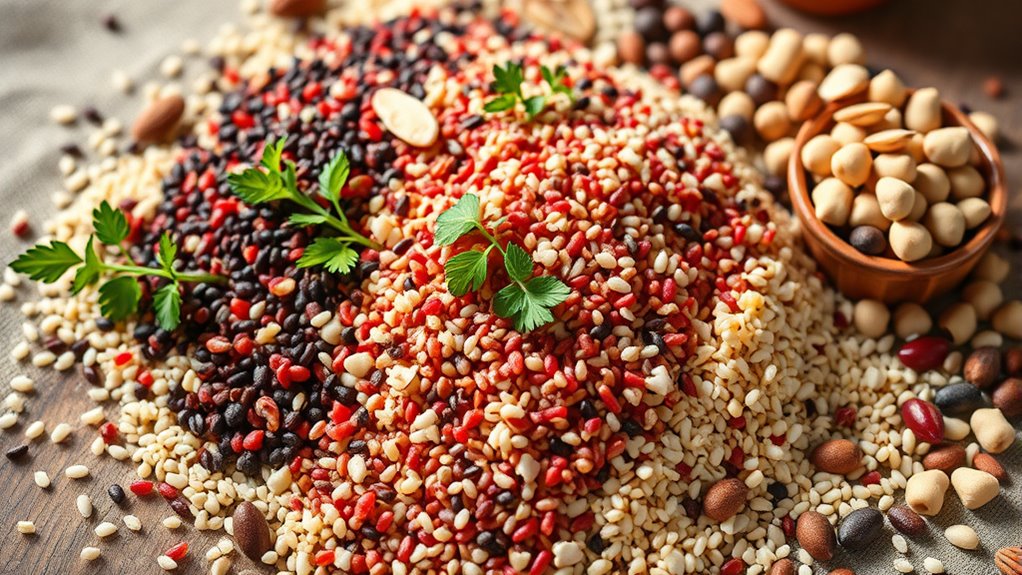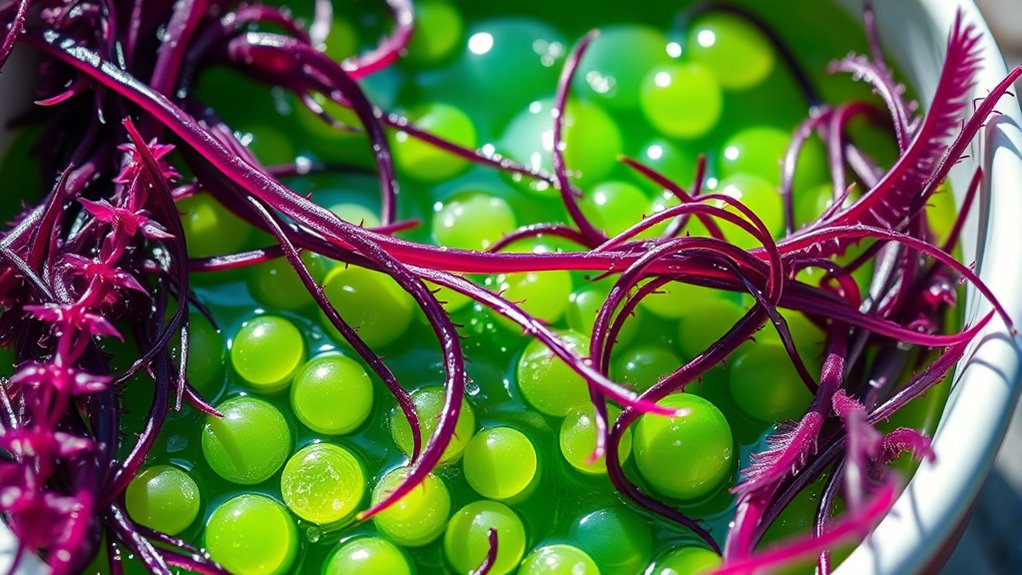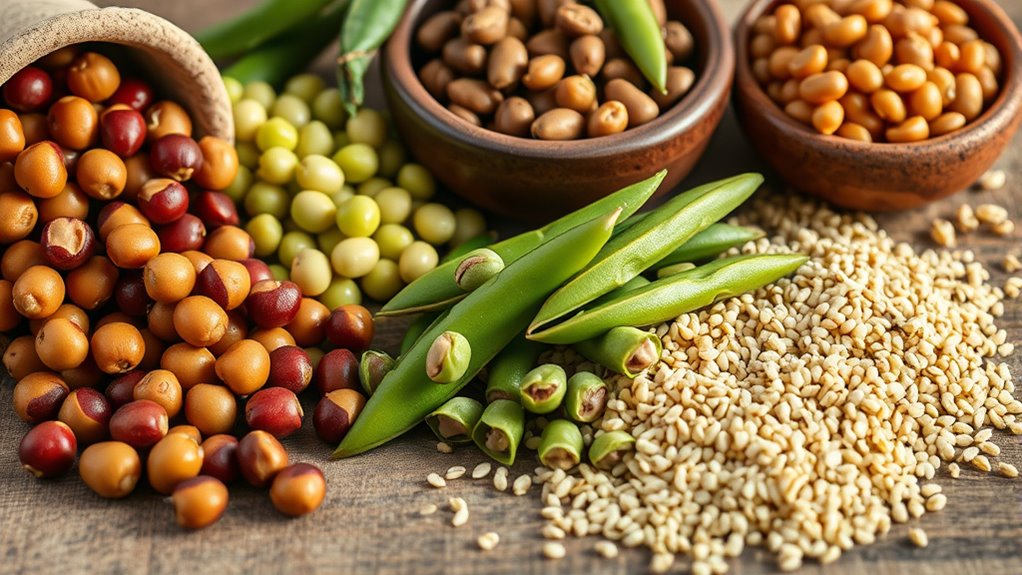Beyond soy, you can explore legumes like lentils, chickpeas, and peas, which are rich in protein and support sustainable farming. Whole grains such as quinoa, oats, and barley also provide complete protein and fiber, broadening your plant-based options. Insect protein is a sustainable alternative, offering high-quality nutrients with minimal environmental impact. Algae, seaweed, nuts, and seeds add variety and nutrition. Discovering these sources can help diversify your diet and promote eco-friendly choices — there’s plenty more to uncover!
Key Takeaways
- Legumes like lentils, chickpeas, and peas are excellent plant-based protein sources beyond soy.
- Quinoa, oats, barley, and farro provide complete or high-quality proteins with added fiber and nutrients.
- Insects such as crickets and mealworms offer sustainable, nutrient-dense protein options with minimal environmental impact.
- Algae and seaweed-based proteins are sustainable, nutrient-rich alternatives with bioactive compounds beneficial for health.
- Nuts and seeds like almonds, pumpkin seeds, and nut butters supply healthy fats and plant-based protein for diverse diets.
Legumes: Lentils, Chickpeas, and Peas

Legumes like lentils, chickpeas, and peas are excellent plant-based protein sources that can easily be incorporated into your diet. Their cultivation supports sustainable farming practices because legumes fix nitrogen in the soil, reducing the need for synthetic fertilizers. This natural process improves soil health and lowers environmental impact, making legume cultivation an eco-friendly choice. Growing these crops requires less water compared to many other protein sources, further emphasizing their sustainability. By choosing lentils, chickpeas, and peas, you contribute to environmentally responsible agriculture while diversifying your protein intake. Incorporating legumes into your meals is straightforward—add them to salads, soups, or stews, and enjoy their nutritional benefits without compromising ecological health. Additionally, these crops are among the top best-selling anime movies, highlighting their popularity and cultural significance worldwide. Their versatility in cooking also makes them a popular choice for plant-based diets around the globe. Using sustainable farming practices when cultivating these crops further reduces their environmental footprint and promotes eco-friendly agriculture. Incorporating crop rotation and cover cropping with legumes can also enhance soil fertility and support personal growth and development by fostering a deeper connection to sustainable living practices.
Quinoa and Other Whole Grains

Quinoa and other whole grains offer impressive nutritional benefits, including complete protein profiles and fiber content that support your health. To maximize their potential, learn the best cooking methods and flavor-boosting tips to make them more enjoyable. Incorporating these grains into your meals is easy with simple ideas that add variety and nutrition to your diet. Additionally, understanding the importance of proper food safety when preparing grains can help prevent contamination and ensure optimal health benefits. Utilizing data analysis can further optimize meal planning and ingredient choices for better health outcomes. Recognizing the chemical composition of grains can also aid in preparing them safely and enhancing their nutritional value.
Nutritional Profile Highlights
While quinoa often steals the spotlight among whole grains, other options like oats, barley, and farro also pack impressive nutritional benefits. These grains have high micronutrient density, offering essential minerals such as magnesium, zinc, and iron. Their protein bioavailability varies but remains a crucial component of plant-based diets. Incorporating a diverse range of grains ensures you get a broader spectrum of nutrients.
- Quinoa provides complete protein, making it especially valuable for plant-based diets.
- Oats are rich in soluble fiber, supporting heart health and digestion.
- Barley and farro offer significant amounts of B-vitamins, enhancing energy metabolism.
Together, these grains elevate your nutritional profile beyond just protein, broadening your plant-based options.
Cooking and Preparation Tips
To achieve the best texture and flavor from whole grains like oats, barley, and farro, proper preparation is essential. Rinse grains thoroughly to remove any debris and excess starch, which helps improve their texture. Cooking with broth instead of water can naturally boost flavor, while adding herbs or spices during simmering enhances taste. You might also explore fermentation techniques, such as soaking grains overnight, to promote digestion and develop deeper flavors. Toasting grains lightly before cooking adds a nutty note and can improve flavor complexity. Be sure to monitor cooking times to prevent over-softening. Once cooked, let grains rest briefly to absorb residual moisture. Incorporating nutritional benefits storage techniques can help keep your pantry organized and make meal prep more efficient. These tips ensure your whole grains are flavorful, tender, and ready to elevate your plant-based meals.
Incorporating Into Diet
Incorporating quinoa and other whole grains into your diet is simple and versatile. These plant-based protein sources beyond soy enhance your meals while supporting sustainable farming practices. To maximize their benefits, consider these approaches:
- Experiment with culinary innovations by adding cooked quinoa to salads, bowls, or veggie patties, boosting protein content and flavor.
- Swap rice or pasta with whole grains like farro or barley to diversify your nutrient intake and promote sustainable agriculture.
- Incorporate these grains into breakfast options, such as quinoa porridge or grain-based smoothies, to start your day with energy and plant-based protein.
- Incorporate plant-based proteins like chia seeds into your recipes for added nutrition and health benefits.
- Explore nutrient-dense grains that offer a variety of essential vitamins and minerals to support overall well-being.
- Remember that adding a variety of fiber-rich foods like whole grains and seeds can help improve digestion and satiety throughout the day.
- Utilizing trusted sourcing methods for whole grains ensures quality and supports responsible farming practices.
Insects as a Sustainable Protein Source

Insects offer a highly sustainable way to meet your protein needs, requiring markedly less land, water, and feed than traditional livestock. They’re also packed with essential nutrients, providing high-quality protein, vitamins, and minerals. Incorporating insects into your diet could be both environmentally friendly and nutritionally beneficial. For example, some edible insects have been identified as dog breeds – My dog names, highlighting their diversity and potential as a sustainable protein source. Since insects have a low environmental footprint, they can significantly reduce the ecological impact associated with conventional animal farming. Their rapid reproduction rates make them an efficient protein source capable of supporting sustainable food systems.
Environmental Benefits of Edible Insects
Because edible insects require substantially less land, water, and feed than traditional livestock, they offer a highly sustainable protein source. This minimizes the environmental impact of food production. By practicing entomophagy benefits, you help reduce greenhouse gas emissions and conserve natural resources. Here are three key environmental advantages:
- Lower greenhouse gas emissions – insects produce considerably fewer emissions than cattle or pigs.
- Efficient feed conversion – insects require less feed to produce the same amount of protein.
- Reduced land use – insect farming needs minimal space, preserving ecosystems. Additionally, integrating sustainable farming practices can further enhance environmental benefits. Recognizing the importance of habitat preservation can help maintain biodiversity and ecological balance as we adopt more sustainable protein sources. Promoting environmentally friendly methods in insect farming can optimize resource use and minimize ecological footprints, aligning with wood stove safety guidelines to ensure environmentally responsible practices.
Nutritional Advantages of Insects
Building on the environmental benefits of edible insects, their impressive nutritional profile makes them an even more compelling sustainable protein option. Insects are rich in high-quality protein, containing all essential amino acids your body needs. They also provide crucial nutrients like iron, zinc, and vitamin B12, which are often lacking in plant-based diets. The entomophagy health benefits extend beyond nutrition; consuming insects may improve digestion and boost immunity due to their prebiotic components. Plus, insects have a low fat content with healthy omega-3 and omega-6 fatty acids. Their digestibility rivals that of traditional meats, making them an efficient protein source. Additionally, research into nutritional benefits continues to reveal how insects can support overall health and wellness in a sustainable way. As the interconnectedness of individual and collective energy becomes more evident, incorporating insects into diets can contribute to broader environmental and health goals. Moreover, the ease of farming insects with minimal resources further enhances their role as a sustainable food source. Overall, insects offer a nutrient-dense, sustainable alternative that supports your health while reducing environmental impact.
Algae and Seaweed-Based Proteins

Algae and seaweed-based proteins are gaining recognition as sustainable and nutrient-rich alternatives to traditional plant-based sources. They thrive through marine cultivation, which minimizes land use and reduces environmental impact. These marine plants are packed with bioactive compounds that offer health benefits like anti-inflammatory and antioxidant properties. To deepen your understanding, consider these key points:
- They are a sustainable source due to rapid growth and minimal resource requirements.
- Marine cultivation allows for scalable production without competing with land-based crops.
- Their bioactive compounds not only enhance nutritional value but also provide potential functional benefits.
Nuts and Seeds With High Protein Content

Nuts and seeds are valuable plant-based protein sources that offer a sustainable and nutrient-dense alternative to marine-based options. They are versatile and easy to incorporate into your diet through snack options like seed snacks or spread as nut butter on toast. Almonds, peanuts, and pumpkin seeds pack a protein punch, supporting muscle growth and overall health. Nut butters provide a convenient way to boost your protein intake while adding healthy fats. Seeds like chia, hemp, and sunflower seeds also contribute essential amino acids and fiber. You can enjoy these in smoothies, salads, or as snacks on the go. With their high protein content and nutrient density, nuts and seeds are excellent choices for anyone seeking plant-based, whole food options to diversify their protein sources.
Emerging Plant-Based Protein Isolates and Textured Foods

As consumer demand for plant-based options grows, innovative protein isolates and textured foods are rapidly emerging in the market. Advances like plant-based protein fermentation enable the development of new protein sources with enhanced functionality. Novel protein extraction techniques, such as aqueous and enzymatic methods, improve yield and purity, making these proteins suitable for textured foods. Here are three key innovations:
- Fermented plant proteins that offer improved digestibility and flavor profiles.
- Textured protein isolates mimicking meat’s texture, produced through extrusion or spinning techniques.
- Novel extraction methods reveal alternative sources like pulses, algae, and fungi for sustainable, high-quality proteins.
These emerging technologies expand your options beyond soy, pushing the boundaries of plant-based protein innovation.
Frequently Asked Questions
How Do Plant-Based Proteins Compare Nutritionally to Animal Proteins?
You might wonder how plant-based proteins compare nutritionally to animal proteins. Generally, plant proteins have lower protein digestibility and may lack some essential amino acids, affecting their amino acid profile. However, combining different plant sources can improve amino acid balance. While animal proteins often have a more complete amino acid profile and higher digestibility, plant-based options can still support your nutritional needs when varied and properly planned.
What Are the Environmental Benefits of Choosing Plant-Based Proteins?
Imagine your choices as a ripple in a pond; choosing plant-based proteins creates waves of positive change. When you opt for these, you support sustainable farming practices that use less water and energy. You also help conserve biodiversity by reducing habitat destruction caused by livestock. Your decision helps protect our planet’s delicate balance, making the earth healthier and more resilient for future generations.
Are Plant-Based Proteins Suitable for All Dietary Restrictions?
You might wonder if plant-based proteins suit all dietary restrictions. While many are allergy considerations, like nuts or legumes, others like grains and seeds often fit diverse diets. Cooking versatility makes them adaptable for various recipes, but always check for potential allergens. With careful selection, you can include these proteins in your diet, ensuring nutritional needs are met while respecting your restrictions.
How Can I Incorporate Diverse Plant Proteins Into My Daily Diet?
Picture a palette full of powerful plant proteins. You can start your day with protein-packed breakfast ideas like chia pudding or quinoa bowls. Snack alternatives like roasted chickpeas or trail mix boost your energy. Incorporate diverse plant proteins by experimenting with lentils, beans, or seeds in salads, soups, or wraps. This variety keeps your diet vibrant, nutritious, and satisfying, helping you meet your daily protein needs effortlessly.
What Are the Latest Innovations in Plant-Based Protein Technology?
The latest innovations in plant-based protein technology include lab-grown proteins and microbial fermentation. You can now enjoy more sustainable, versatile options that mimic animal proteins closely. Lab-grown proteins are developed in labs, reducing environmental impact, while microbial fermentation uses microorganisms to produce proteins efficiently. These advancements give you exciting new ways to incorporate diverse, high-quality plant-based proteins into your diet, expanding beyond traditional sources like soy.
Conclusion
Exploring plant-based proteins beyond soy opens exciting options for sustainable eating. Did you know that pea protein production requires 90% less water than beef? By incorporating diverse sources like legumes, grains, and algae, you can markedly reduce your environmental footprint while enjoying nutritious meals. Embrace these alternatives to diversify your diet and support a more sustainable future. Every choice counts—your switch to plant-based proteins can make a meaningful impact.










